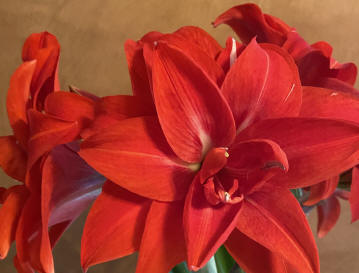 Winter can be a long season of gray skies and barren trees and bushes. During this time, autumn hues have faded and colorful perennials lie in dormancy in the drab landscape. The simple fact is that people are generally happier surrounded by color. A bleak environment can lead to feelings of sadness and melancholy, while an environment bursting with bright hues can create a delightful atmosphere. A suggestion to obtain more cheerfulness in your surroundings is to enhance your home in the winter with colorful houseplants while adding air-purifying qualities to the home.
Winter can be a long season of gray skies and barren trees and bushes. During this time, autumn hues have faded and colorful perennials lie in dormancy in the drab landscape. The simple fact is that people are generally happier surrounded by color. A bleak environment can lead to feelings of sadness and melancholy, while an environment bursting with bright hues can create a delightful atmosphere. A suggestion to obtain more cheerfulness in your surroundings is to enhance your home in the winter with colorful houseplants while adding air-purifying qualities to the home.
Tradescantia is a species of spiderwort native to South America. This classic winter houseplant exhibits attractive foliage. Depending on the species, tradescantias are typically purple and often variegated with silvers, greens, creams, and even pinks. It prefers full sun and well-drained soil.
Aglaonema, commonly known as Chinese evergreen, is a low maintenance tropical perennial available in several cultivars that make excellent houseplants. It is tolerant of low light conditions and can add a burst of pleasing hues. If you are looking for a plant with stunning foliage, this plant has dark green, silver, or pink foliage and will thrive easily in your home.
Cyclamen persicum, commonly called Cyclamen, is especially popular during the winter holidays where you will find it growing in garden centers. It is a tuberous perennial, meaning it dies back to its thick tubers during its summer dormancy period, and then rejuvenates in the fall. Its flowers can be shades of pink, purple, red, and white. Cyclamen thrive in well-drained soil and bright, indirect light.
Thanksgiving and Christmas cacti are a colorful addition to a home in the winter. They need bright indirect light, with a daytime temperature around 70 degrees and an evening temperature around 65 degrees. Be cautious not to overwater because this plant is a succulent. Their beautiful blooms, which can be pink, red, white, purple, or salmon, will adorn your home for several months during the winter.
Crown of Thorns (Euphorbia milii) is a favorite of mine. I was immediately attracted to its delicate pink blooms and unique structure. It is a succulent that features thick black spines on its stems. Crown of Thorns will bloom continuously the entire year, which is a rare characteristic for a plant. Crown of Thorns prefers a sunny location in the home and well-drained soil. In the summer, Crown of Thorns is a unique outdoor attraction when placed in a container on a patio.
Saving the best for last, is the Amaryllis. This exquisite plant is a favorite Christmas flower. One look at the bloom will convince anyone that this is a showstopper. Amaryllis blooms range from 4 to 10 inches in size and can be either single or double in form. While the most popular colors are red and white, flowers may also be pink, salmon, apricot, rose, or deep burgundy. Amaryllis grows from a bulb and it is not unusual to have at least 3 blooms on each stem per bulb.
After blooming, Amaryllis is a showy houseplant with long green leaves. In the summer, it can be placed outdoors in a protected and sunny area. If it is brought inside in the fall and placed in a dormancy period, it will produce new blooms when brought out into a sunny location. Be adventurous and grow a collection of Amaryllis. Bring these plants out of dormancy at different intervals to ensure blooming Amaryllis in your home throughout the winter months.
This is a sampling of houseplants that display colorful foliage and blooms. There are others to select as well. Most houseplants are relatively easy to grow when placed in the right environment. Read the tags or research its care and growth requirements. The most common pests are spider mites, mealy bugs, and aphids. If detected early, they can be controlled by gently wiping off the foliage with water. If it is heavily infested, the pests can be controlled with an insecticidal soap. Overwatering and under-watering are the most common reasons for unsuccessful growth of houseplants. Many varieties of houseplants must be kept away from small children and pets because of their toxicity.
If you desire more information about houseplants, the Penn State Master Gardeners of Adams County are presenting workshops about houseplants. Details about these classes are listed below with the link to register.
Read other winter related to winter plants